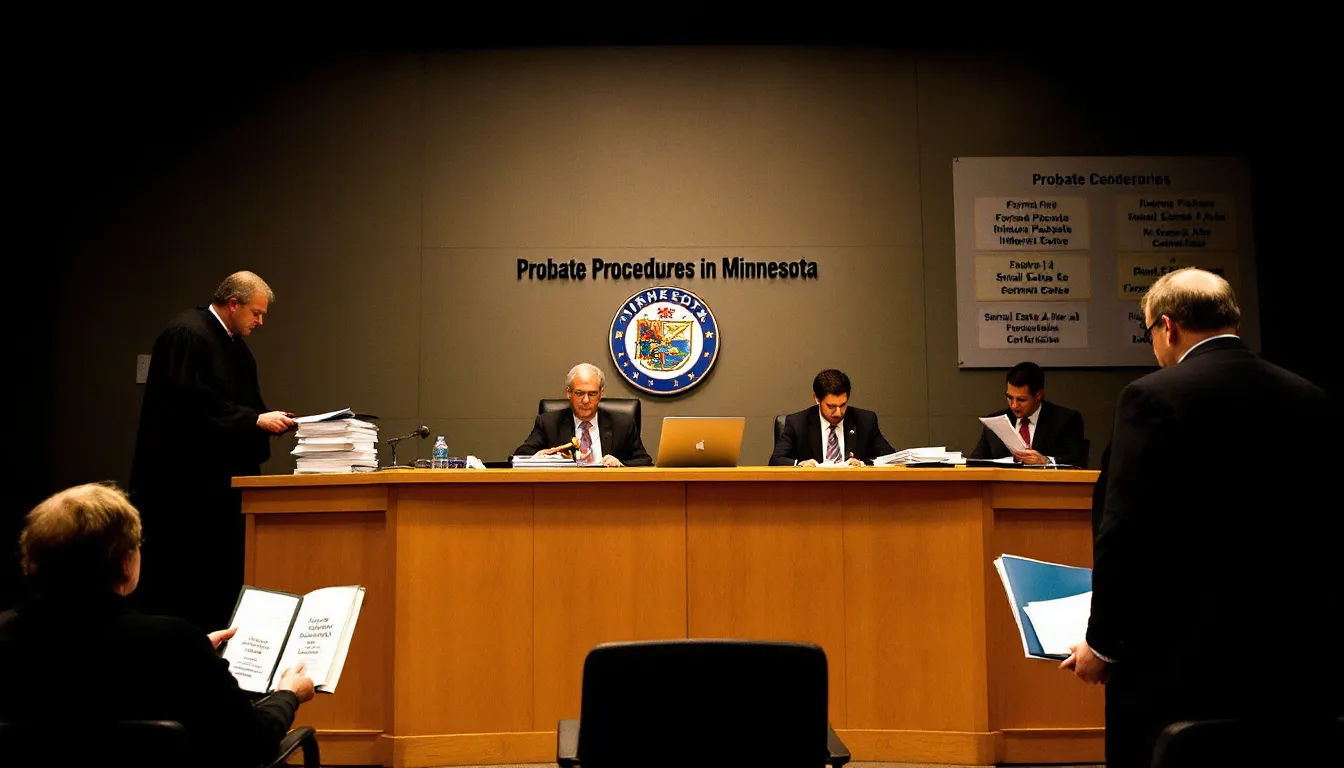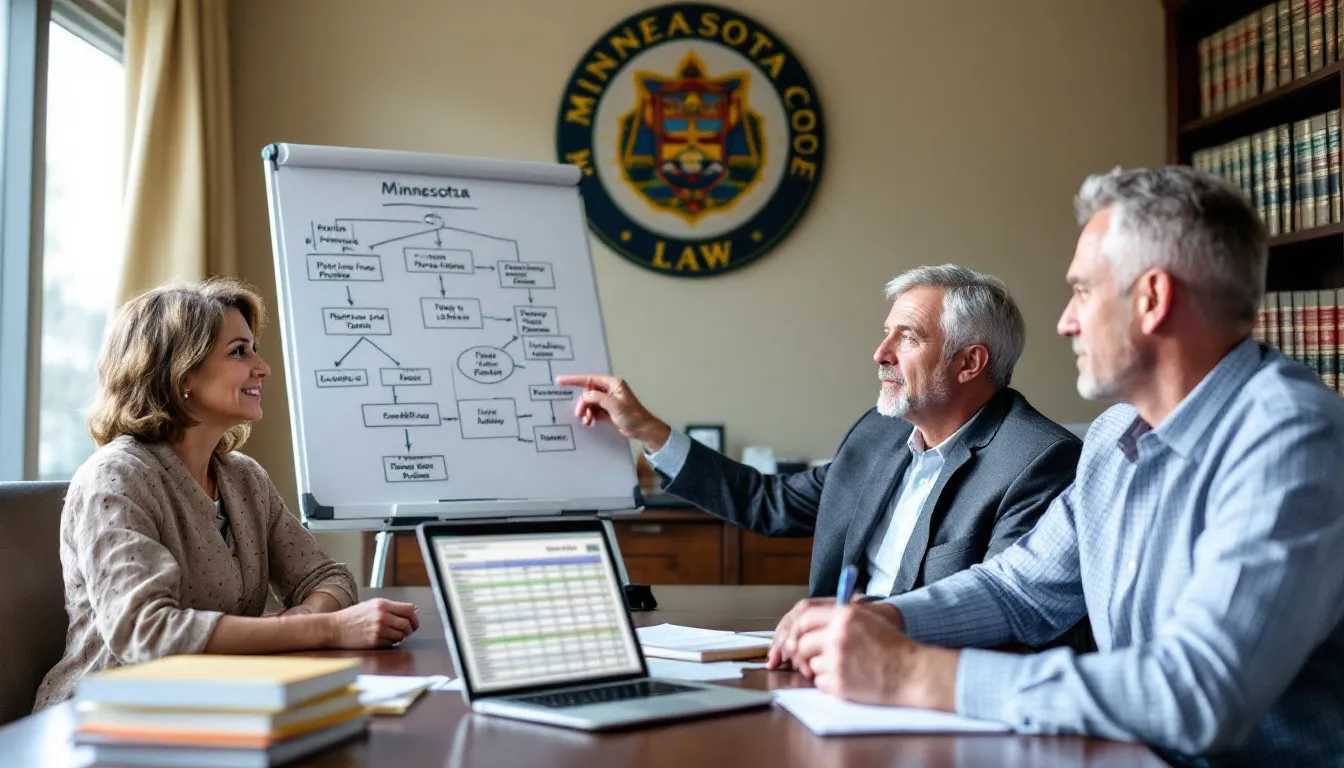Mastering Minnesota Probate: A Comprehensive Guide to Navigating Estate Law
Minnesota probate is the legal (court) process for transferring a deceased person's assets. A decedent's assets that are not transferred by non-probate mechanisms -- such as a life estate that terminates automatically at death, a beneficiary designation on a life insurance policy or financial account, or a pay on death checking account -- must be transferred through a probate court proceeding.
Introduction to Estate Law
Estate law in Minnesota is a complex and multifaceted field that deals with the distribution of a decedent’s assets after their death. The probate process is a crucial part of estate law, as it ensures that the decedent's probate assets are distributed either according to their wishes, as outlined in their will, or by statute if there is no will. A personal representative, also known as an executor, is responsible for managing the decedent’s estate and carrying out the probate process. This involves filing the necessary paperwork with the probate court, notifying creditors and beneficiaries, and distributing the estate’s assets according to the decedent’s wishes. Understanding the probate process and the role of the personal representative is essential for ensuring that the decedent’s estate is handled properly and that their wishes are carried out.
Key Takeaways
-
The Minnesota probate process is essential for transferring property after death, involving the management of the deceased’s assets and settling debts, regardless of whether a will exists.
-
Key steps include filing a petition to appoint a personal representative, conducting an inventory of assets, determining the appropriate probate procedure based on estate complexity, and ensuring the final distribution of the estate's assets is overseen by the court to ensure all legal requirements are met.
-
Although some may seek to avoid probate through strategies like revocable living trusts or joint tenancy, probate offers legal protections and ensures adherence to the decedent’s wishes and proper asset distribution.
Understanding the Minnesota Probate Process

Probate is a legal process required for transferring property after someone’s death. It involves obtaining court authority to proceed with the transfer. Its primary purpose is to settle the estate of a deceased person by managing and distributing their assets while ensuring all debts are paid. The need for probate is not determined by the existence of a will but by the type of assets owned at death.
The probate process begins after the decedent's death and involves understanding both probate and nonprobate assets. Certain assets require probate if they were owned individually by the deceased at the time of death. Probate assets include properties that necessitate court intervention for transfer, whereas non-probate assets can be transferred without it.
Resolving all claims against the estate is necessary before distributing remaining assets to beneficiaries. Grasping these basics is key to navigating the probate process and understanding how to claim your rights.
Key Steps in the Minnesota Probate Process
The probate process in Minnesota starts with filing a petition and appointing a personal representative. Key steps include filing the initial petition and conducting an inventory and appraisal of the estate’s assets, as outlined in Minnesota statutes. The personal representative is responsible for managing the decedent's estate, including settling debts and distributing assets.
Filing the Petition
To initiate probate, a petition must be filed with the court in the county where the deceased resided at the time of death. This petition requests the court to appoint a personal representative to manage the decedent’s estate. The petition can be filed formally or informally, with the latter not requiring a court hearing. However, in certain circumstances, such as when the validity of the will is contested, formal probate, which involves a court hearing, is necessary.
Submitting the original will, if available, and notifying interested parties are part of the party petition filing. This process can be time-consuming and may necessitate an attorney’s help to ensure proper preparation and file of a legal document, taking into account the interests of all involved, including medical assistance.
After filing the petition, the court reviews it and, if requirements are met, issues an order to proceed with probate proceeding.
Appointment of Personal Representative
The court appoints a personal representative, also known as an executor, to manage the estate during probate. This appointment happens after notice of informal probate is given and the estate is officially opened.
The personal representative is responsible for managing the decedent's property, including real estate and personal belongings. The personal representative gains legal authority through a court order, allowing them to manage the estate’s assets, settle debts, and distribute remaining assets to beneficiaries. This crucial role requires acting prudently and lawfully.
Inventory and Appraisal of Assets
The personal representative must inventory and appraise the decedent's assets, including real property, tangible property, tangible personal property, and financial accounts. Accurate inventorying ensures proper management and distribution under probate law.
Identifying all probate assets, such as real estate, retirement accounts, and brokerage accounts, is crucial. The personal representative must settle all debts before distributing remaining assets, providing a clear estate’s assets value and meeting legal obligations regarding the account.
Types of Probate Procedures in Minnesota

Minnesota law categorizes probate into formal and informal probate, based on estate complexity. Informal probate suits simpler cases, allowing personal representative appointments without a court hearing, thus expediting the process with less judicial oversight. The probate registrar plays a crucial role in reviewing applications and granting informal probate, ensuring the proper appointment of personal representatives.
Conversely, formal probate requires a court hearing for complex estates needing judicial oversight. Within formal probate, supervised probate procedures involve specific filings and deadlines with ongoing judicial oversight, while unsupervised procedures allow personal representatives to manage the estate without continuous court supervision after initial approval.
Role and Responsibilities of the Personal Representative
The personal representative is pivotal to the probate process, responsible for collecting, inventorying, and appraising the decedent's assets. They must protect and manage the estate prudently, acting as a fiduciary with a high standard of care and loyalty.
Handling outstanding debts, including verifying creditors claims and managing insufficient funds, is a critical responsibility. Engaging a probate attorney can help manage disputes, ensure legal compliance, and reduce personal liability. Additionally, the representative must distribute the estate according to any valid will and applicable laws.
Personal representatives are authorized to handle estate distribution based on the will and legal framework. They can sue and be sued, inheriting the decedent legal standing. Their role ensures the probate process is smooth and lawful for all persons involved.
Property Ownership and Probate
In Minnesota, property ownership is a critical factor in determining whether probate is necessary. Generally, probate is required when a person dies owning property in their sole name, such as real property or tangible personal property. However, if the property is owned jointly with another person, such as a spouse or business partner, probate may not be necessary. This is because joint ownership typically includes a right of survivorship, which means that the surviving owner automatically inherits the property upon the death of the other owner. Additionally, certain types of property, such as life insurance policies and retirement accounts, may also be exempt from probate if they have a designated beneficiary. Understanding the different types of property ownership and how they affect the probate process is essential for navigating the complexities of estate law in Minnesota.
Parties Involved in Probate
The probate process involves several parties, including the personal representative, beneficiaries, creditors, and the probate court. The personal representative is responsible for managing the decedent’s estate and carrying out the probate process. Beneficiaries are the individuals or organizations that are entitled to receive a portion of the decedent’s estate, as outlined in their will or trust document. Creditors are individuals or organizations that have a claim against the decedent’s estate, such as unpaid debts or taxes. The probate court is responsible for overseeing the probate process and ensuring that the decedent’s estate is handled properly. In Minnesota, the probate court may also appoint a supervised administrator to oversee the probate process, particularly in complex or contested cases. Understanding the roles and responsibilities of each party involved in the probate process is essential for ensuring that the decedent’s estate is handled properly.
Navigating Complex Probate Issues

Complex probate issues, such as family disputes over will validity or asset distribution, often arise and may require probate court supervision. The probate process aims to facilitate orderly asset distribution, reducing conflicts and fostering beneficiary trust.
Other complexities include ambiguous or impossible provisions, vulnerable parties needing special attention, and the necessity for supervised administration. Recognizing and preparing for these challenges can aid in navigating the impossible provisions probate process more effectively.
Probate Timeline and Duration
The probate timeline and duration can vary significantly depending on the complexity of the estate and the specific circumstances of the case. In Minnesota, the probate process typically begins with the filing of a petition with the probate court, which can occur within a few days or weeks after the decedent’s death. The probate process can take anywhere from a few months to several years to complete, depending on the complexity of the estate and the level of cooperation among the parties involved. Generally, informal probate proceedings are less time-consuming and less expensive than formal probate proceedings, which require court supervision and may involve more complex administration procedures. Understanding the probate timeline and duration is essential for planning and preparing for the probate process.
Avoiding Probate in Minnesota

While probate has benefits, some opt to avoid it to simplify estate distribution and cut legal costs. A revocable living trust allows asset management during one’s lifetime and post-death distribution without probate. Joint tenancy with right of survivorship ensures property automatically passes to the surviving owner, bypassing probate.
Certain strategies allow for the transfer of assets to a new owner without going through probate. Naming beneficiaries directly on retirement accounts and life insurance helps avoid probate. A transfer-on-death deed lets property owners designate a real estate beneficiary who inherits automatically upon the owner’s death. These strategies simplify estate management and distribution.
Common Myths About Minnesota Probate
A common myth is that probate always takes a long time. In fact, many estates, particularly smaller ones, can be settled quickly. Another misconception is that all family members are willing to manage probate, highlighting the importance of designating a personal representative.
Many believe probate is inherently long and complicated, causing misconceptions about estate management. Appointing a personal representative streamlines the process, ensuring clarity and efficiency in managing the estate.
Benefits of Probate

Probate validates a will legally, ensuring the decedent’s wishes are honored and recognized by the court. It protects against creditor claims by establishing a formal debt-settling process before asset distribution. Probate also ensures the legal validation and proper distribution of the decedent's property. Personal representatives gain court authority through probate, aiding in the legal management and distribution of estate assets.
Open communication among heirs can minimize conflicts and streamline probate. Probate is often required for assets solely in the deceased’s name, especially if they include real estate or exceed $75,000, including small estates, from the decedent’s estate and the decedent’s property. An heir can help facilitate this process.
Despite its challenges, probate offers numerous advantages, such as legal protections and proper asset distribution.
Seeking Professional Guidance
Seeking professional guidance is essential for navigating the complexities of the probate process in Minnesota. A qualified attorney can provide invaluable assistance and guidance throughout the probate process, from filing the initial petition to distributing the estate’s assets. An attorney can help ensure that the probate process is handled properly and that the decedent’s wishes are carried out. Additionally, an attorney can provide guidance on Minnesota law and the specific requirements of the probate process, including the preparation of necessary documents and the notification of creditors and beneficiaries. In complex or contested cases, an attorney may also be necessary to represent the interests of the personal representative or beneficiaries in court. By seeking professional guidance, individuals can ensure that the probate process is handled efficiently and effectively, and that the decedent’s estate is distributed according to their wishes.
Ready to Settle an Estate with Confidence? We Can Help.
Probate in Minnesota can feel daunting, but you don’t have to tackle it alone. The Steve Wilson Law Office guides personal representatives and families through every phase of the process—from filing the initial petition and securing court authority to inventorying assets, paying creditors, and making the final distributions. Your first consultation is free and obligation-free; if we’re not the best fit, we’ll still point you toward reputable resources so the estate is handled correctly.
Whether you’re opening probate for the first time, resolving a contested will, or converting an informal case to supervised administration, our attorneys break down each step—choosing the right procedure, meeting statutory deadlines, preparing court-approved documents, and protecting beneficiaries’ rights—so you stay compliant and in control.
📞 Call our Minnesota office at (952) 250-0075 or use our secure contact form to book your complimentary evaluation today. Let us manage the legal details while you focus on honoring your loved one’s legacy.
Summary
Navigating the Minnesota probate process can be complex, but understanding its key aspects can make it more manageable. From filing the initial petition to appointing a personal representative and inventorying assets, every step is crucial. Probate ensures that the decedent’s wishes are honored, debts are settled, and assets are distributed fairly.
By understanding the different types of probate procedures, the role of the personal representative, and strategies to avoid probate, you can effectively manage or plan an estate. Whether dealing with complex issues or debunking myths, being well-informed will help you navigate probate with confidence and clarity.
Frequently Asked Questions
What is the primary purpose of probate in Minnesota?
The primary purpose of probate in Minnesota is to settle the decedent's estate by managing and distributing their assets and ensuring that any debts are appropriately paid. This process helps provide clarity and finality for the deceased’s affairs.
When is formal probate necessary?
Formal probate is necessary in cases where the estate contains complexities requiring judicial oversight, such as will disputes or substantial debts. This process ensures that all legal and financial matters are resolved appropriately.
What are the responsibilities of a personal representative?
A personal representative is tasked with collecting and managing the decedent's assets, settling debts, and distributing the estate in accordance with the will and applicable laws. This role is crucial for ensuring an orderly and fair administration of the estate.
How can probate be avoided in Minnesota?
To avoid probate in Minnesota, you can establish a revocable living trust, create joint ownership with rights of survivorship, designate beneficiaries on your accounts, or utilize a transfer-on-death deed. These strategies can effectively streamline your estate management.
What are some common myths about probate?
One prevalent myth is that probate is always lengthy and complex; however, many estates can be resolved swiftly, particularly with an appointed personal representative. It is essential to understand that the probate process can vary significantly depending on the circumstances.
How does probate work in Minnesota?
In Minnesota, probate is the legal process that involves the probate court overseeing the management and distribution of a decedent’s estate, ensuring that all debts are settled and the remaining assets are distributed according to the will or state law if no valid will exists. The probate process begins after the decedent's death and involves managing and distributing their assets.
How much does an estate have to be worth to go to probate in Minnesota?
In Minnesota, an estate must generally exceed $75,000 in value to require probate. Estates valued below this threshold may qualify for simplified procedures, allowing for quicker and less costly asset distribution.
How do you avoid probate in MN?
To avoid probate in Minnesota, establish a revocable living trust, hold property in joint tenancy with rights of survivorship, designate beneficiaries on retirement accounts and life insurance, or use a transfer-on-death deed for real estate, ensuring a smooth transfer of assets without court intervention.
Do it yourself probate in Minnesota without a will?
Handling probate in Minnesota without a will involves a personal representative managing the decedent's estate through the probate court, following Minnesota statutes to ensure proper distribution of assets and settlement of debts, even in the absence of a valid will.